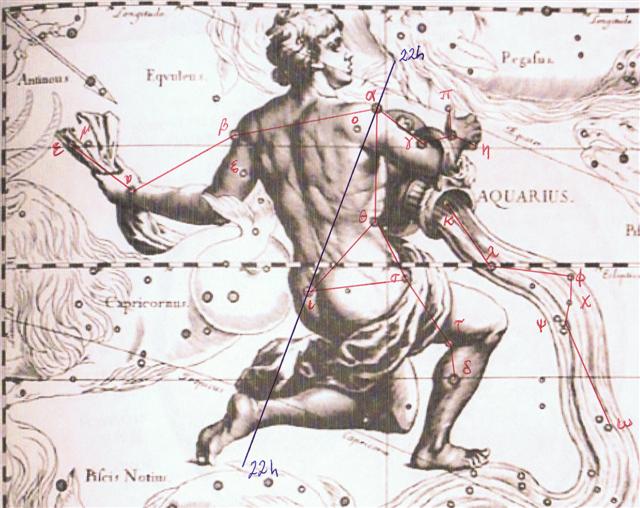In rongorongo times
Sadalmelik (α)
rose with the
Sun at 22h:
Sadalsud (β) rose heliacally 9 days earlier in February 9:
I have earlier missed redmarking 46 (c) Capricorni, which according to the Arabs belonged in their 22nd manazil. As to Lucia this day is connected with the great star Sun: "... a discrepancy of 8 days would have been the case in the Julian calendar during the 14th century, resulting in Winter solstice falling on December 13. With the original adoption of the Gregorian calendar in the 16th century the discrepancy was 10 days and had increased to 11 days in the 18th century when Scandinavia adopted the new calendar, with Winter solstice falling on December 9." (Wikipedia) The 12 glyphs beginning with Gb2-6 are probably divided in a pair of groups (6 + 6) with a kind of vero terminating the first group and with a haś at the end of the second group. Lucia should be celebrated in the early morning of December 13 (ideally winter solstice north of the equator). I.e. in the center of the 12-night long solstice period. In the time of Taurus, it could have been calculated, these 12 nights began with the heliacal rising of Sadalsud, in night number 261 (= 9 * 29) from 0h. In rongorongo times 64 nights had to be added in order to find heliacal Sadalsud. 261 + 64 = 325 (alluding to March 25). And then by converting right ascension nights to the Gregorian calendar: 80 + 325 = 405 = 40 (February 9). Gregory XIII had changed spring equinox from March 25 to March 21, but these 4 days could in rongorongo times be elmininated because precession since the 16th century had moved Sadalsud ahead with 4 days. A new Sun year began after the (northern) winter solstice and vero in Gb2-11 has 4 feather marks at left and 3 at right. (4 + 3) * 52 = 364. Haś in Gb2-17 has 7 + 12 = 19 feather marks (with number 7 drawn extra large).
| ||||||||||||||||||||||||||||||||||||||||||||||||||||||||||||||||||||||||





